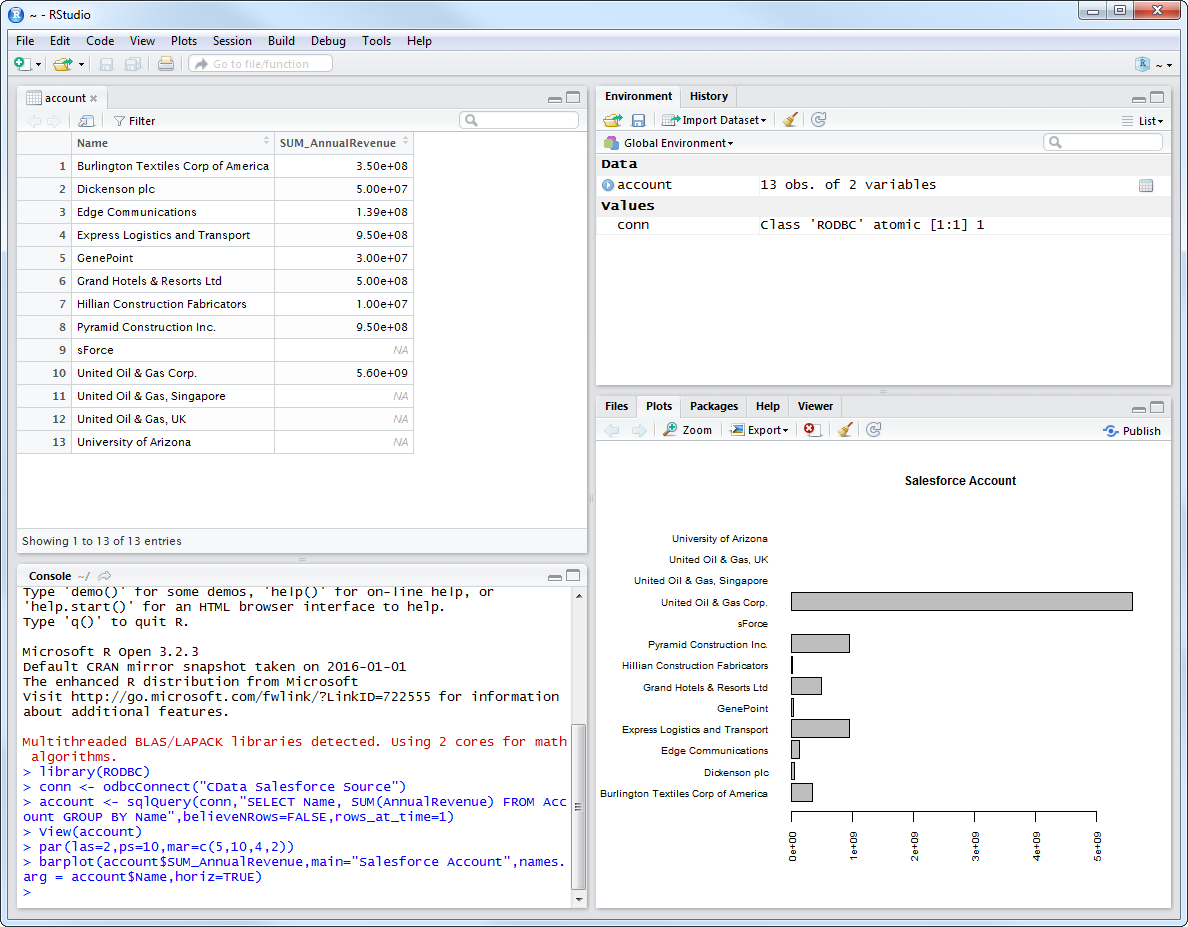Discover how a bimodal integration strategy can address the major data management challenges facing your organization today.
Get the Report →Analyze Dynamics 365 Data in R
Create data visualizations and use high-performance statistical functions to analyze Dynamics 365 data in Microsoft R Open.
Access Dynamics 365 data with pure R script and standard SQL. You can use the CData ODBC Driver for Dynamics 365 and the RODBC package to work with remote Dynamics 365 data in R. By using the CData Driver, you are leveraging a driver written for industry-proven standards to access your data in the popular, open-source R language. This article shows how to use the driver to execute SQL queries to Dynamics 365 data and visualize Dynamics 365 data in R.
About Dynamics 365 Data Integration
CData simplifies access and integration of live Microsoft Dynamics 365 data. Our customers leverage CData connectivity to:
- Read and write data in the full Dynamics 365 ecosystem: Sales, Customer Service, Finance & Operations, Marketing, and more.
- Extend the native features of Dynamics CRM with customizable caching and intelligent query aggregation and separation.
- Authenticate securely with Dynamics 365 in a variety of ways, including Azure Active Directory, Azure Managed Service Identity credentials, and Azure Service Principal using either a client secret or a certificate.
- Use SQL stored procedures to manage their Dynamics 365 entities - listing, creating, and removing associations between entities.
CData customers use our Dynamics 365 connectivity solutions for a variety of reasons, whether they're looking to replicate their data into a data warehouse (alongside other data sources)or analyze live Dynamics 365 data from their preferred data tools inside the Microsoft ecosystem (Power BI, Excel, etc.) or with external tools (Tableau, Looker, etc.).
Getting Started
Install R
You can complement the driver's performance gains from multi-threading and managed code by running the multithreaded Microsoft R Open or by running R linked with the BLAS/LAPACK libraries. This article uses Microsoft R Open (MRO).
Connect to Dynamics 365 as an ODBC Data Source
Information for connecting to Dynamics 365 follows, along with different instructions for configuring a DSN in Windows and Linux environments.
Edition and OrganizationUrl are required connection properties. The Dynamics 365 connector supports connecting to the following editions: CustomerService, FieldService, FinOpsOnline, FinOpsOnPremise, HumanResources, Marketing, ProjectOperations and Sales.
For Dynamics 365 Business Central, use the separate Dynamics 365 Business Central driver.
OrganizationUrl is the URL to your Dynamics 365 organization. For instance, https://orgcb42e1d0.crm.dynamics.com
When you configure the DSN, you may also want to set the Max Rows connection property. This will limit the number of rows returned, which is especially helpful for improving performance when designing reports and visualizations.
Windows
If you have not already, first specify connection properties in an ODBC DSN (data source name). This is the last step of the driver installation. You can use the Microsoft ODBC Data Source Administrator to create and configure ODBC DSNs.
Linux
If you are installing the CData ODBC Driver for Dynamics 365 in a Linux environment, the driver installation predefines a system DSN. You can modify the DSN by editing the system data sources file (/etc/odbc.ini) and defining the required connection properties.
/etc/odbc.ini
[CData Dynamics365 Source]
Driver = CData ODBC Driver for Dynamics 365
Description = My Description
OrganizationUrl = https://myaccount.operations.dynamics.com/
Edition = Sales
For specific information on using these configuration files, please refer to the help documentation (installed and found online).
Load the RODBC Package
To use the driver, download the RODBC package. In RStudio, click Tools -> Install Packages and enter RODBC in the Packages box.
After installing the RODBC package, the following line loads the package:
library(RODBC)
Note: This article uses RODBC version 1.3-12. Using Microsoft R Open, you can test with the same version, using the checkpoint capabilities of Microsoft's MRAN repository. The checkpoint command enables you to install packages from a snapshot of the CRAN repository, hosted on the MRAN repository. The snapshot taken Jan. 1, 2016 contains version 1.3-12.
library(checkpoint)
checkpoint("2016-01-01")
Connect to Dynamics 365 Data as an ODBC Data Source
You can connect to a DSN in R with the following line:
conn <- odbcConnect("CData Dynamics365 Source")
Schema Discovery
The driver models Dynamics 365 APIs as relational tables, views, and stored procedures. Use the following line to retrieve the list of tables:
sqlTables(conn)
Execute SQL Queries
Use the sqlQuery function to execute any SQL query supported by the Dynamics 365 API.
goalheadings <- sqlQuery(conn, "SELECT GoalHeadingId, Name FROM GoalHeadings WHERE Name = 'MyAccount'", believeNRows=FALSE, rows_at_time=1)
You can view the results in a data viewer window with the following command:
View(goalheadings)
Plot Dynamics 365 Data
You can now analyze Dynamics 365 data with any of the data visualization packages available in the CRAN repository. You can create simple bar plots with the built-in bar plot function:
par(las=2,ps=10,mar=c(5,15,4,2))
barplot(goalheadings$Name, main="Dynamics 365 GoalHeadings", names.arg = goalheadings$GoalHeadingId, horiz=TRUE)






